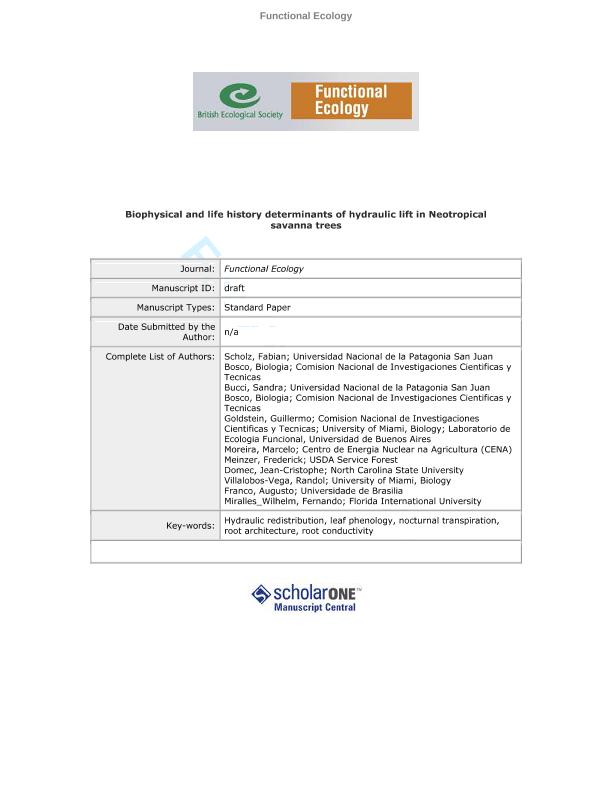Mostrar el registro sencillo del ítem
dc.contributor.author
Scholz, Fabian Gustavo

dc.contributor.author
Bucci, Sandra Janet

dc.contributor.author
Goldstein, Guillermo Hernan

dc.contributor.author
Moreira, M. Z.
dc.contributor.author
Meinzer, F.C.
dc.contributor.author
Domec, J. C.
dc.contributor.author
Villalobos Vega, R.
dc.contributor.author
Franco, A. C.
dc.contributor.author
Miralles Wilhelm, F.
dc.date.available
2022-11-29T13:28:55Z
dc.date.issued
2008-12
dc.identifier.citation
Scholz, Fabian Gustavo; Bucci, Sandra Janet; Goldstein, Guillermo Hernan; Moreira, M. Z.; Meinzer, F.C.; et al.; Biophysical and life-history determinants of hydraulic lift in Neotropical savanna trees; Wiley Blackwell Publishing, Inc; Functional Ecology; 22; 5; 12-2008; 773-786
dc.identifier.issn
0269-8463
dc.identifier.uri
http://hdl.handle.net/11336/179382
dc.description.abstract
1. Ecological and physiological characteristics of vascular plants may facilitate or constrain hydraulic lift. Studies of hydraulic lift typically include only one or few species, but in species-rich ecosystems a larger number of representative species needs to be studied. 2. Measurements of sap flow in tap roots, lateral roots and stems, as well as stable isotope labelling techniques were used to determine the occurrence and relative magnitude of hydraulic lift in several individuals of nine co-occurring Brazilian savanna (Cerrado) tree species differing in life-history traits, and to assess physical and biological determinants of this process at the tree and ecosystem level. 3. The occurrence of reverse sap flow observed in deciduous and brevideciduous species during the dry season was consistent with hydraulic lift. The evergreen species did not exhibit reverse flow. Consistent with their ability to carry out hydraulic lift, the brevideciduous and deciduous species had both shallow and tap roots (dimorphic root systems), whereas the evergreen species had mostly deep roots (monomorphic root systems). 4. In the deciduous and brevideciduous species, the contribution of tap roots to transpiration increased substantially as the dry season progressed. Seasonal changes in the contribution of tap roots to transpiration were not observed in the evergreen species. 5. There was an inverse relationship between rates of reverse sap flow and seasonal loss of hydraulic conductivity in lateral roots, suggesting that hydraulic lift in Cerrado woody plants may help maintain the functionality of the lateral roots in exploring dry and nutrient rich superficial soil layers without directly enhancing the amount of water uptake. 6. Reverse sap flow in lateral roots of the deciduous and brevideciduous species increased asymptotically as the driving force for water movement from roots to the soil increased. This nonlinear relationship implies that additional sinks for water such as nocturnal transpiration and refilling of internal water storage tissues may compete for internal water resources during the dry season. 7. There appears to be a trade-off between greater year-round access to nutrients in the upper soil layers (deciduous and brevideciduous species) and a greater access to deep and more reliable water sources during the dry season (evergreen species), which has implications for whole-ecosystem water, carbon and nutrient balance in Neotropical savannas. © 2008 The Authors.
dc.format
application/pdf
dc.language.iso
eng
dc.publisher
Wiley Blackwell Publishing, Inc

dc.rights
info:eu-repo/semantics/openAccess
dc.rights.uri
https://creativecommons.org/licenses/by-nc-sa/2.5/ar/
dc.subject
HYDRAULIC REDISTRIBUTION
dc.subject
LEAF PHENOLOGY
dc.subject
NOCTURNAL TRANSPIRATION
dc.subject
ROOT ARCHITECTURE
dc.subject
ROOT CONDUCTIVITY
dc.subject.classification
Ecología

dc.subject.classification
Ciencias Biológicas

dc.subject.classification
CIENCIAS NATURALES Y EXACTAS

dc.title
Biophysical and life-history determinants of hydraulic lift in Neotropical savanna trees
dc.type
info:eu-repo/semantics/article
dc.type
info:ar-repo/semantics/artículo
dc.type
info:eu-repo/semantics/publishedVersion
dc.date.updated
2021-12-13T19:21:41Z
dc.journal.volume
22
dc.journal.number
5
dc.journal.pagination
773-786
dc.journal.pais
Reino Unido

dc.journal.ciudad
Londres
dc.description.fil
Fil: Scholz, Fabian Gustavo. Consejo Nacional de Investigaciones Científicas y Técnicas; Argentina. Universidad Nacional de la Patagonia "San Juan Bosco"; Argentina
dc.description.fil
Fil: Bucci, Sandra Janet. Consejo Nacional de Investigaciones Científicas y Técnicas; Argentina. Universidad Nacional de la Patagonia "San Juan Bosco"; Argentina
dc.description.fil
Fil: Goldstein, Guillermo Hernan. University of Miami; Estados Unidos. Universidad de Buenos Aires; Argentina. Consejo Nacional de Investigaciones Científicas y Técnicas; Argentina
dc.description.fil
Fil: Moreira, M. Z.. Universidade de Sao Paulo; Brasil
dc.description.fil
Fil: Meinzer, F.C.. United States Forest Service; Estados Unidos
dc.description.fil
Fil: Domec, J. C.. North Carolina State University; Estados Unidos
dc.description.fil
Fil: Villalobos Vega, R.. University of Miami; Estados Unidos
dc.description.fil
Fil: Franco, A. C.. Universidade do Brasília; Brasil
dc.description.fil
Fil: Miralles Wilhelm, F.. Florida International University; Estados Unidos
dc.journal.title
Functional Ecology

dc.relation.alternativeid
info:eu-repo/semantics/altIdentifier/doi/http://dx.doi.org/10.1111/j.1365-2435.2008.01452.x
dc.relation.alternativeid
info:eu-repo/semantics/altIdentifier/url/https://besjournals.onlinelibrary.wiley.com/doi/10.1111/j.1365-2435.2008.01452.x
Archivos asociados
